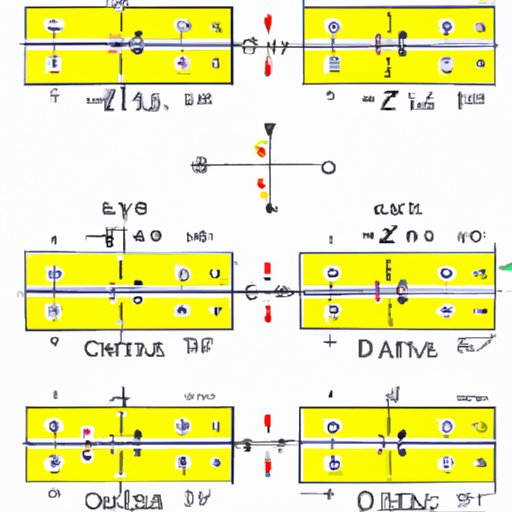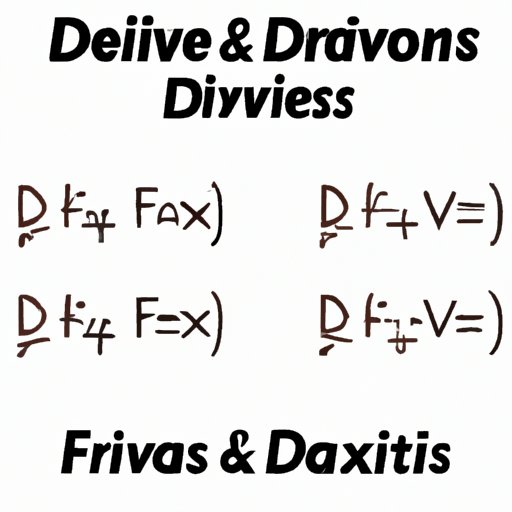
Introduction
Calculus can be a challenging subject. And one of the most challenging aspects of calculus is finding derivatives. Derivatives are an integral part of calculus, and understanding how to find them is crucial to success in the subject. In this article, we will explore how to find derivatives step-by-step, from mastering the basics to proven techniques for finding derivatives of tricky functions. By the end of this comprehensive guide, you’ll have the knowledge and confidence to find derivatives of any function.
Mastering the Basics: A Step-by-Step Guide on How to Find Derivatives
Before diving into the more complicated aspects of calculus, it’s important to start with the basics. The derivative of a function is a measure of how that function changes as its input changes. We can define the derivative of a function f(x) as the limit of the difference quotient as h approaches 0.
There are several basic rules for finding derivatives, such as the power rule, product rule, and quotient rule. The power rule states that if the function f(x) = x^n, then the derivative is f'(x) = nx^(n-1). The product and quotient rules are used for finding derivatives of functions that are the product or quotient of two or more functions. It’s important to master these basic rules before moving on to more advanced techniques.
Examples are a great way to illustrate how to use these rules. For example, let’s find the derivative of the function f(x) = x^3. Using the power rule, we know that f'(x) = 3x^2. Another example is finding the derivative of the function f(x) = x^2 + 2x. Using the sum rule, we can find that f'(x) = 2x + 2.
It’s important to note that there are common mistakes when finding derivatives, such as forgetting to apply the chain rule or the product rule correctly. One tip for avoiding common mistakes is to double-check your work and make sure you’re using the correct rule for each function.

From High School to College: Tips on How to Find Derivatives of Functions
High school calculus is often more straightforward than college-level calculus, but there are techniques used in college-level calculus that can make finding derivatives easier and more efficient. It’s important to adapt to the new level of difficulty and become familiar with more advanced techniques, such as the chain rule and implicit differentiation.
The chain rule is used for finding the derivative of composite functions, where one function is inside another. For example, let’s find the derivative of f(x) = sin(2x). Using the chain rule, we can find that f'(x) = 2cos(2x).
Implicit differentiation is used for functions that are not explicitly defined in terms of y. For example, let’s find the derivative of the function x^2 + y^2 = 25. Using implicit differentiation, we can find that the derivative of y with respect to x is dy/dx = -x/y.
Unlocking the Mystery: How to Find Derivatives of Complex Functions Simplified
Finding derivatives for complex functions can be a challenge, but there are strategies for simplifying functions before finding their derivatives. One technique for simplifying functions is logarithmic differentiation, which can be used for functions that are the product or quotient of more than two functions.
Logarithmic differentiation involves taking the natural logarithm of both sides of an equation, then differentiating both sides with respect to x. For example, let’s find the derivative of the function f(x) = x^(2x). Using logarithmic differentiation, we can simplify the function and find that f'(x) = x^(2x) * (2 + ln(x)).
Derivatives 101: An Introduction to Calculus for Beginners
If you’re new to calculus, it can be a daunting subject. However, understanding derivatives is a great place to start. Derivatives are the foundation of calculus, and many other calculus concepts build upon this knowledge. It’s important to start with the basics and work your way up.
Basic derivative rules include the power rule, product rule, quotient rule, and chain rule. Let’s look at an example of how to use these rules to find the derivative of the function f(x) = 3x^2. Using the power rule, we know that f'(x) = 6x. Another example is finding the derivative of the function f(x) = x^2 * e^x. Using the product rule and chain rule, we can find that f'(x) = x^2 * e^x + 2x * e^x.
Maximizing Function Efficiency: How to Find Derivatives Easily and Quickly
When working with derivatives, there are shortcuts and tricks that can help you find them quickly and easily. One such shortcut is using the power rule in reverse to integrate a function. Another shortcut involves recognizing patterns in functions and applying shortcuts accordingly.
However, it’s important to minimize errors when using shortcuts. One tip is to double-check your work and make sure you’re applying the correct shortcut.
Proven Techniques for Finding Derivatives of Tricky Functions
Tricky functions, such as trigonometric and exponential functions, require specialized techniques for finding their derivatives. For example, let’s find the derivative of the function f(x) = sin(x). Using the derivative of sine rule, we can find that f'(x) = cos(x).
It’s also important to identify which technique to use for a given function. For example, if you’re working with an exponential function, you’ll need to use the exponential rule to find its derivative.
Mastering Calculus: A Comprehensive Guide to Finding Derivatives of Any Function
This article has covered a lot of ground when it comes to finding derivatives. From mastering the basics to advanced techniques for finding derivatives of tricky functions, we’ve explored everything you need to know to become proficient in calculus.
However, the key to mastering calculus is practice. The more you practice finding derivatives, the more confident and proficient you’ll become. There are also additional resources available for learning calculus, such as textbooks, online resources, and tutors.
Conclusion
In conclusion, finding derivatives is an essential part of calculus. Understanding how to find derivatives is crucial for success in the subject. From mastering the basics to finding derivatives of tricky functions, we’ve explored everything you need to know to become proficient in calculus. With practice and additional resources, you’ll be well on your way to mastering calculus.




